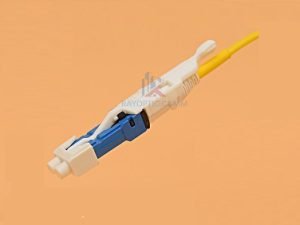In the realm of optical communications, the relentless pursuit of enhanced efficiency has led to remarkable innovations. Among these, the advent of the CS Connector marks a significant evolution, offering a compelling alternative to the traditional LC Duplex Connector. With a focus on a compact design, lightweight construction, and rapid data transmission, the CS Connector sets a new standard in network connectivity.
Miniaturization: The New Frontier in Network Design
The current trajectory in network infrastructure design is clear: smaller, more efficient components are the future. This trend towards miniaturization is not merely about saving space—it’s about enabling higher densities and greater speeds within existing frameworks. The introduction of Very Small Form Factor (VSFF) Connectors is a direct response to this need, with the CS Connector at the forefront of this movement.
CS Connector: A Study in Compact Excellence
The CS Connector stands out with a design that is 40% smaller than the LC Duplex Connector. This significant size reduction translates into increased port density, which is critical for scaling up network capabilities without expanding the physical footprint. The CS Connector doesn’t just save space; it also paves the way for higher data throughput, supporting the infrastructure demands of current and future technologies.
A Comparative Look at Optical Performance
The CS Connector shines in its optical performance, boasting an impressive insertion loss of just 0.10 dB to 0.20 dB, and a return loss of ≥55 dB for UPC and ≥65 dB for APC configurations. When compared to the LC Duplex Connector, the CS Connector offers improved signal integrity, which is vital for maintaining the quality of data transmission across complex networks.
Designed for High-Speed Data Networks
With the increasing demand for faster data rates, the CS Connector is designed to meet and exceed the requirements of 400G networking. Its suitability for high-speed data environments is evident in its compatibility with QSFP-DD, OSFP, and SFP-DD transceivers, making it an essential component for modern networking applications.
Installation and Usability: A Superior Approach
Ease of installation and usability are at the heart of the CS Connector’s design. Its push-pull mechanism and identifiable keying features enable simple and efficient handling, especially in high-density configurations where space and time are at a premium. The connector’s design facilitates quick and secure connections, reducing the risk of downtime and enhancing overall network reliability.
The Future of Connectivity
As network infrastructures evolve, the selection of connectors becomes a critical decision point. The CS Connector, with its forward-thinking design, is poised to become the standard for those seeking a sophisticated approach to network design and implementation. Its attributes are perfectly aligned with the industry’s move towards more efficient, scalable, and high-performing networking solutions.
The CS Connector represents the next step in the evolution of fiber optic connectivity. By embodying the principles of being smaller, lighter, and faster, it offers a substantial improvement over the LC Duplex Connector. As networking demands continue to grow, the CS Connector is uniquely positioned to meet these challenges, providing an innovative solution that enhances network efficiency and sets the stage for the future of high-density, high-speed communications.


